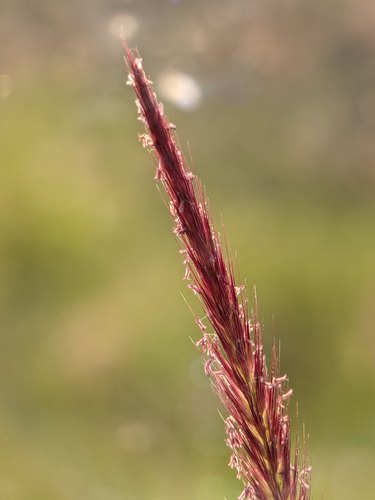
Purple fountain grass (Pennisetum setaceum 'Rubrum' and 'Purpureum,' also called red fountain grass) is unique in its versatility. Not only can it be grown as a perennial or an annual but the attractive, droopy grass with its feathery purple-red plumes is considered an invasive pest in some areas while being welcome in others. Its showy foliage and dramatic plumes bring year-round visual interest to any garden, so if you live in a suitable climate and take precautions to prevent spreading, it's well worth your consideration. Here's what you need to know about purple fountain grass care.
Is Purple Fountain Grass a Perennial?
Video of the Day
Purple fountain grass grows as a perennial in USDA plant hardiness zones 8-11, but the plant dies back in winter in colder climates. Because of this, most gardeners outside of those hardiness zones grow purple fountain grass as an annual or a container plant. Dwarf or standard varieties in containers are perennial in colder climates but only if containers spend winter indoors. (Dwarf cultivars can thrive in smaller containers, so they're easier to move.) Any reasonably sunny indoor area will work, from a corner of your living room to an enclosed deck or porch.
Video of the Day
Purple Fountain Grass Care
Purple fountain grass has a clumping habit and grows up to 5 feet tall, with colorful blossom plumes appearing in summer and fall. The ornamental grass is rarely bothered by pests or disease, is deer-resistant and is generally considered a low-maintenance landscaping plant. Occasional trimming is one of the few routine tasks required.
While it's perfectly fine to leave fountain grass alone from year to year, trimming old or dead growth keeps the plant looking neater and healthier. Because it is a warm-season grass, the best time to cut back fountain grass is when it's dormant during late fall or winter. Fountain grass may be pruned down to the crown if desired. Pruning keeps old, faded foliage from marring the beauty of fresh new growth, which appeals to our very human eye for neatness.
Tip
Though the grass isn’t especially susceptible to infection, it’s always good practice to sterilize pruning shears with rubbing alcohol before and after use.

Dividing Fountain Grass Periodically
As a perennial, purple fountain grass continues to expand from year to year, forming large, dense clumps. Sections of these clumps can become choked and can wilt or fail, making the grass planting appear sickly and unkempt. Dividing clumps in late winter or early spring before growing season alleviates crowding while doubling (or more!) the number of grass plants decorating a yard. If you have friends or neighbors who've admired the plant's purple foliage, it's also an opportunity to share the plant with others.
Simply dig one up, being careful not to damage roots, and separate the root ball into two or more parts depending on its size. Replant one in the original spot and plant the others about 3 feet apart (wide enough to allow for growth and in-filling) in holes as deep as the roots originally were and twice as wide. Backfill the holes and water thoroughly to keep soil moist (but not wet) until roots reestablish themselves. Fountain grasses have a rapid growth rate, so your new plantings will look full within their first season.
Nutrient Needs for Fountain Grass

Purple fountain grasses thrive in full sun and are moderately drought-tolerant. Virtually care-free, the plants normally need no fertilizer and do well on less than 20 in. of water annually. During extreme heat or extended dry periods, provide enough water to keep soil moist but not wet.
A 4-in. layer of organic mulch surrounding (but not touching) the base of the plant helps keep roots cool and conserves moisture. Organic mulch also adds nutrients to soil as it decomposes, further reducing the need for added fertilizer. If the plant needs more nutrition, evenly spread 1/4 to 1/2 cup of complete, all-purpose granular fertilizer around the root zone and water in well. The time to do this is in spring, right around the period when new growth begins to appear.
Purple Fountain Grass as an Ornamental
With its arching plumes and foliage color, purple fountain grass is an eye-catching plant. A bit of forethought can help you maximize its impact in your landscape. For example, if you have no trees or shrubs to bring structure to your space, a planting of fountain grass lends a tall focal point to a bed filled with smaller flowers or herbs.
The grass can be used to flank an entrance, to line a walkway or in a mass planting to create a border between spaces in your yard (perhaps dividing the kids' play area from the adults' relaxation area). It's effective around water features or as a bold backdrop to other foliage-forward ornamentals with pale or golden leaves.

The plants' tall, nodding plumes lend additional interest at bloom time in late summer and into autumn (they show to great advantage alongside a light-colored wall). The flower color of the plumes ranges from a deep rose-red through varying shades of purple-red and purple depending on the cultivar and individual variation. Indoors, tall plumes make a striking addition to bouquets and cut-flower arrangements, complementing other seasonal blooms.
Tip
Although their appearance would theoretically work well in dried arrangements, they don’t work well in practice. The plumes turn to seed heads as they mature, which then fall apart and scatter seeds over the surrounding area (your furniture!). It works well in nature but not indoors.
Potential Downsides to Fountain Grass
Purple fountain grass cultivars are considered to be potentially invasive depending where you live. In cooler climates, they'll rarely set the seeds that would cause your plants to spread willy-nilly all over the landscape, but it can happen (especially in warmer climates). Planting in containers or sites that have natural barriers, such as curbs, also keeps fountain grass under control. You can aid matters by removing plumes before they go to seed.
In winter, fountain grass can become dry as tinder and can burn easily. Other types of ornamental plants, such as flax, lavender or clumping bamboo, may be better choices in areas prone to wildfire. Another point to remember is that like other ornamental grasses, fountain grass has sharp edges (especially when leaves are dry and stiff) that can cause painful cuts. Wear work gloves or heavy gardening gloves when handling fountain grass.

With a dash of care and attention, you'll soon be tending to beautiful, healthy and vibrant purple fountain grass. Here's to your next gardening endeavor!